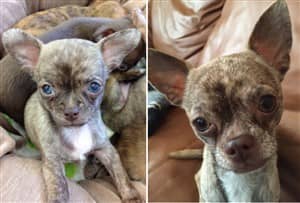Chihuahua Color Changes
Skin, Nose, and Coat
Overview
Color changes may happen with a Chihuahua in regard to both skin and coat. Some are gradual changes that occur naturally as a Chihuahua matures and other changes are due to environmental elements or health conditions.
Please note:
PetChiDog is reader-supported. Some of the product suggestions on this page are affiliate links. As an Amazon Associate we earn from qualifying purchases. This is at no extra cost to you and helps keep this site running.
Skin Color Changes
Many pet parents ask about their Chihuahua puppy or dog's skin developing dark spots, ranging from brown to black. These may be circular or irregular, and tiny like freckles or rather large. When dark spots appear on a Chihuahua's skin, this may be noticeable through a light colored coat (tan, white, fawn, etc.). And while it can happen on any part of the body, this will usually occur on the stomach which has sparse fur.
The #1 Reason
The most common reason that this happens is due to sun exposure. When a Chihuahua's skin is exposed to UV rays, a process called hyperpigmentation can occur in which the body reacts by overproducing melanin which causes the spots, or freckles, to develop.
This is rather common because the Chihuahua breed is notorious for being sunbathers that really enjoy soaking in the sun's rays. Some will seek out a sunny spot in the house; others will take advantage of the opportunity to lay belly up outside on warm, summer days.
If a pigmentation change is indeed due to exposure to sunlight it may lessen or completely go back to its normal color during winter months when the sun is not as strong and days are shorter (more so for those who live in areas that experience four seasons).
In and of itself, if the skin is flat and there are no other signs or symptoms other than the color change, this is usually not related to a health issue and there is no reason to be concerned.
Health Issues that can Cause Skin Color Changes
There are several health issues and skin issues that can cause a Chihuahua's skin to discolor, including:
1) Vasculitis. This is an inflammation of blood vessels due to a variety of reasons; one of which is a bad reaction to vaccination shots which can manifest as reddish-purple spots. Other signs of this include painful areas on the body most notably on the paws, lips and tail, swelling in the legs, itchy skin, ulcers, lack of appetite, and/or fever.
2) Allergies. In most cases, there will be rashes, scaling and pink irritated areas, however with some dogs - especially with chronic cases - the skin may turn black or purple. Other signs are itching, coughing, shortness of breath, wheezing, runny eyes, runny nose, and/or sneezing.
3) Sweat Gland Cysts. A Chihuahua's sweat glands can become inflamed which can cause black, raised nodules.
4) Hypothyroidism. This refers an under-active thyroid gland that does not produce enough thyroid hormones. In later stages of untreated hypothyroidism, a dog's skin can turn black. There will other symptoms as well including a thinning of the coat, dry skin, weight gain, and/or change in appetite.
5) Other Causes. Other less common issues that can cause a dog's skin to discolor include Bowen Disease, skin infection, cancer, parasites, and yeast infections.
Change in Nose Color
What color is a Chihuahua's nose? While a deep, dark black nose is common, a Chihuahua may also have a tan nose (this is referred to as self-colored in tan or fawn coated dogs), blue (the nose will be dark with a navy tint and any Chihuahua with a blue nose will officially be deemed a blue Chihuahua, no matter the actual color of the fur), chocolate (brown), and possibly pink or spotted pink (though many newborns have pink noses, pink noses as an adult is most commonly seen with Chihuahuas that have white spotting on the coat).
Yet, the nose can change color over time. In most cases, the cause is genetic or not serious (and temporary or reversible) and more information is ahead; less common but possible are health issues including lupus erythematosus and skin cancer.
Example of Nose Filling in with Color
If your Chihuahua puppy has a pink nose or a pink spotted nose, you may be wondering if the color will fill in. The younger the pup, the higher the chance that it will. If your Chi is around the 8 week old mark, the chances are about 50/50. And, once a Chi is several months old, chances are low.
A great example of a Chihuahua's pink nose turning darker to its genetically predetermined color is cute little Georgie, seen below. As a young pup, his nose was a mix of pink and chocolate, and the nose marking looked like a little heart. Then, seen again as a one year old, this Chihuahua's nose is nearly solid chocolate.
Photos courtesy of Cindy E.
Noses Fading in Color or Developing Pink Spots
There are several possible reasons why a Chihuahua's nose will fade, become lighter, or develop white or pink spots:
• Plastic bowls. A chemical reaction with plastic (most often in the case of plastic bowls) can cause the nose to fade. This may happen even with bowls that are PBA and/or PVC-free. This can usually be reversed within a few months by using stainless-steel bowls like Vivaglory's Stainless Steel Bowl Set
 which is a set of two (for food and for water) set into a non-skid rubber mat to contain any messes. Alternatively, ceramic can work good as well.
which is a set of two (for food and for water) set into a non-skid rubber mat to contain any messes. Alternatively, ceramic can work good as well.
• Snow nose, due to lack of exposure to sunlight. Canines need some level of sun exposure for the nose to maintain normal pigmentation. Staying indoors too often can lead to 'snow nose’, also referred to as 'winter nose', in which lighter patches develop. While you can help reverse this by bringing your Chihuahua outside more often, this will typically resolve on its own in the spring and summer when UV rays are stronger, as long as you take your dog outside often enough (two daily walks are recommended).
• Damage from a peeling or cracked nose. A dog's nose color is just on the outer layers. So, if there is peeling or cracking, pink from inner layers on the nose may be exposed. If this occurs, encourage proper hydration and apply a nose balm like Natural Dog Company's Snout Soother
 until the nose color is restored. Use the balm on a regular basis to prevent drying that can lead to peeling and cracking.
until the nose color is restored. Use the balm on a regular basis to prevent drying that can lead to peeling and cracking.
• Dudley nose, also known as nasal depigmentation or vitiligo. This is a genetic condition in which the nose fades over time, sometimes just lightening but sometimes turning completely pink or white. Because this is seen as an aesthetic issue, no treatment is given. A nose faded in this way should be protected with nose balm since it can be very sensitive to sunlight and burn easily.
Should You Be Concerned About Color Changes to the Nose?
If there are no other signs such as cracking, raised areas, itching,
skin problems, etc. the reason will most often be due to the use of plastic, seasonal color changes, damage from peeling, or genetics. If you have any doubts, always consult your Chihuahua's veterinarian who will be able to rule out any
health problems.
Coat Color Changes
One thing that surprises a lot of pet parents is when their Chihuahua’s fur changes color as they mature. It happens gradually, but one day you may look at your older puppy or young adult Chihuahua and realize that they look drastically different than when they were younger.
The Age that Fur Can Change Color
If a Chi’s fur goes through a color transition, this usually happens over the course of the first 18 months.
What Causes Fur to Change Color
Like many other breeds, all Chihuahuas are born with a ‘puppy coat’ which is soft, fine fur. As they mature, their puppy coat slowly transitions over to their adult coat. For some Chihuahuas, this change is barely noticeable; color may stay relativity the same and the fur will simply feel a bit denser. But, for others, the adult fur that grows will undergo a distinct color change.
What Type of Color Changes Can Occur?
Very drastic changes can be ruled out. For example, a red sable cannot change into a solid cream. A black and white puppy cannot mature into a brindled tan, etc.
However, there are lots of changes that can happen. Fur can lighten or darken, markings can diminish or grow larger, patterns (like sable or brindle) can fade or intensify.
In addition to this, as a Chihuahua ages, grey hairs can start appearing. Though you might assume this is something that would only happen to senior dogs in the double digits (age 10 and up), it can actually start much sooner.
Details and Examples of Color Changes with Chihuahuas
Sable Fades
Sable refers to dark tipped hairs over any color base. Chihuahua can be cream sables, red sables, tan sables, etc. Sable fading away is one of the most common color changes that happens to Chihuahua. When this occurs, the Chi will usually look lighter overall, since those dark hairs fall away, typically revealing a lighter base coat underneath.
Cute little Pablo here, is a great example of this. The first photo shows him at 3 months old; there is lots of sable in his coat. The second photo was just 11 months later at the age of 14 months; most of the sable is gone. He looks just as adorable, but clearly has a much different color coat.
Photos courtesy of Leone
Sable Intensifies
Much more infrequently, sable can become more prominent. When this happens, the early puppy coat will hold some amount of sable, even if it is barely noticeable and even if it appears in just a small patch. How much it increases will vary. However, one thing is constant: when sable grows in, a Chihuahua will look darker overall since the dark or black-tipped hairs will create a layer over the base color.
An excellent example of this is pretty Sophie. In the first photo, she is 4 months old. You can see some sable on her table and shoulders. The second photo, taken at about 6 months old, shows how dark her coat became. Taking a look at her back, you can see that lots of black tipped hairs (sable) grew in.
Photos courtesy of Shirley Williams
Brindle Can Change
Brindle is a striped pattern of various colors. It can be light or dark and thin or thick. And, when the puppy coat changes over to the adult coat, the brindle can change as well. Like sable, if it fades, a Chihuahua will look lighter overall. And if it intensifies, a Chihuahua will look darker overall.
The transition can be very subtle like with adorable Dobby here, seen below. As a young pup, there was brindle all along the muzzle, up close against the nose. But, as a 4-year-old young adult Chihuahua, the brindle has faded down a bit and you can see more white fur in this area.
Photos courtesy of Sandra Schluter
White or Colored Markings on a Chihuahua Can Change
Though brindle and sable are technically markings, there are also other types of markings that a Chihuahua can have including a mask (coloring around the eyes) and spotted markings (most often white over another base color) that can appear anywhere on the body.
There are kiss marks (spots on the cheeks), eyebrows can hold their own color, and white can run up between the eyes and up over the forehead (called a blaze with it holds the same width or a flare when it widens).
Any sort of spot can become smaller or larger as a Chihuahua’s coat changes. And, it can fade or intensify in color.
Full Coat Color Change
As we touched on earlier, some drastic types of color changes simply are not possible, such as a red Chihuahua turning into a white Chihuahua or a solid black transitioning into a tan with white spots. But there can definitely be other less extreme transformations.
A common change is a white coat turning into a cream coat, which can be a bit upsetting to those that spent more money for a supposed solid white Chihuahua. Aside from that, most full-body color changes with Chihuahuas tend to be from dark to light. So, it is also common for a red to fade down to an orange and a chocolate Chihuahua (which is based on nose color) with brown fur to slowly develop lighter tan fur.
A good example of a Chihuahua’s main color changing over time is beautiful Mia here, seen below.
As a young pup of just 3 months old, her coat was a very light cream and you can barely see her flare (line of white running between her eyes and up over her forehead) since it’s almost the same color as her main body.
Then, jump ahead to Mia at 2 years old. Her adult fur is now a nice fawn and that flare is much more noticeable now.
Photos courtesy of Mike and Lori
Gray Hairs Growing in on an Adult Chihuahua
As we touched on earlier, dogs can develop gray hairs as they age, much like us humans do. However, the most notable difference is the age at which this happens. With the Chihuahua breed, gray hairs can grow in as early as the 5-year mark which is the age equivalent of 36 human years, though it most often occurs closer to the 8-year mark which is the equivalent of 48 human years, if it is indeed going to happen.
Gray fur can develop just about anywhere on the body; however, it normally happens around the face, on the head, and/or on the chest.
An excellent example of this sort of color change is handsome Chapito. As a younger Chihuahua, his black and tan coat had no gray at all (though he does have a small white spot on his chest). But, jump ahead to Chapito now at the age of 5 years old, and he is growing lots of gray on his muzzle. Don’t you think it makes him look very distinguished?
Photos courtesy of Anna
Ticking: Dark Spots Appearing on White Fur
Ticking refers to dark spots over white areas of fur and it can only occur when the fur is white due to the S locus gene (the spotting gene). So, you usually won’t see this change happen on solid white Chihuahuas.
Some breeds (the Chihuahua is not one of them) can have ticking over their entire body, in which case it is referred to as roan); but with Chihuahuas ticking typically appears on the legs and/or muzzle.
A Chihuahua can be born with ticking, but in other instances, it can develop as the Chi grows. When it develops over time, this is one of the most interesting and rare color changes that can happen with Chihuahuas.
Note that a Chihuahua can carry the ticking gene (the T locus) but not have any white on their body, and therefore the dark spots will not show but that gene can be passed down.
A wonderful example of ticking color on a Chihuahua that grew in over time is little Booley (Boo). Seen here at 11 weeks old, he has no ticking at all (the white areas on his coat do not have any spots).
In this next photo Boo is 16 months old and is showing off the ticking on his front legs. There is also a bit of spotting on his rear saddle.
Photo courtesy of Betty Cooper








